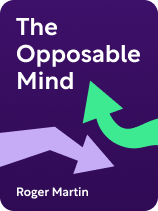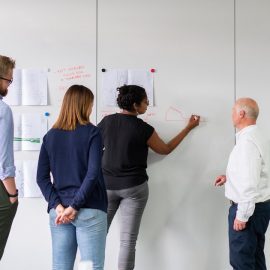

This article is an excerpt from the Shortform book guide to "The Opposable Mind" by Roger Martin. Shortform has the world's best summaries and analyses of books you should be reading.
Like this article? Sign up for a free trial here.
What makes some business leaders more innovative than others? How can you develop the mental agility needed to solve complex problems in today’s fast-paced world?
Roger Martin’s integrative thinking approach offers a framework for developing advanced problem-solving skills. His method combines three essential elements: adopting useful beliefs, applying creative reasoning techniques, and balancing experience with originality.
Keep reading to discover how you can master these cognitive tools and transform your leadership capabilities.
Roger Martin on Integrative Thinking
Aspiring leaders in today’s business world have to mentally navigate the intricacies of technology, politics, and organizational management. You can master the skills that the most effective leaders use if you’re willing to examine and adjust your thinking process. According to Roger Martin, integrative thinking is the ability to consider opposing ideas and create a solution from the best parts of both.
Integrative thinking (or mental integration) entails three key components—a useful set of beliefs about the world (which Martin calls your “stance”), a set of mental methods for generating new ideas, and the ability to apply past experience (“knowledge”) in new ways to solve unfamiliar problems.
(Shortform note: Martin isn’t the only author to delve into the thought process of successful leaders. In Leadershift, John C. Maxwell addresses the mindset changes leaders need to develop so they can keep up in the modern business world. Whereas Martin’s focus is largely introspective—what’s going on in a leader’s mind—Maxwell’s view is somewhat external in that he says leaders should be team-oriented and committed to growth instead of achievement. Maxwell and Martin both tout the value of seeking a diversity of viewpoints, as we’ll cover in the second part of this overview, but Maxwell also emphasizes growing other people’s talents as a means for finding original solutions to business problems.)
Martin explains that the cognitive components of integrative thinking interact and shape each other. For instance, your beliefs determine how you engage in problem-solving, the results of which will add to your knowledge. However, the process also works in reverse—your prior knowledge guides your problem-solving strategies, which in turn refine (and often reinforce) your beliefs about yourself and the world. Martin says this can either be a good or bad thing. If your beliefs are unhelpful, they’ll lead to poor problem-solving and negative experiences that fuel more poor decisions, reaffirming your toxic beliefs. A useful outlook on the world, however, can trigger a positive reward cycle of experience, so that’s where we’ll begin.
(Shortform note: Selecting between beneficial and unhelpful beliefs can be tricky, since our minds are designed to generate beliefs faster than we can keep track of them. In Being Wrong, Kathryn Schulz explains that we automatically form beliefs about every new thing or idea we encounter. We do this because our minds crave explanations, so we feed them by making up theories on the fly, which are sometimes based only on imagination. The trouble is that our guesses quickly solidify into firmly held beliefs that are hard for us to change. The ideas that Martin proposes are beliefs about beliefs, which—if adopted—can hopefully help to make your belief-forming process less rigid.)
Useful Beliefs
When working through a problem that calls for an imaginative solution, your mind creates a simulation of the problem to work with—one that’s shaped by your past experience and unconscious biases. To cut through the static of your own assumptions and be truly creative, Martin argues that you have to see your mental simulation for what it is, actively look for different ways to see the problem, and consciously work through your thinking process.
We often confuse our subjective perceptions with objective reality. Martin says the first useful belief you should accept is that your personal perspective is inaccurate. The uncomfortable truth is that no two people’s views of a problem are exactly the same, and neither is 100% correct. This has been proven time and again when witnesses offer conflicting versions of the exact same events. Martin suggests that nevertheless, most people are content with their own perspective and will even defend it tooth-and-nail. If you can accept that your mental simulation of a problem is distorted, though, then you also have to accept that a superior perspective must exist if you only try to find it.
The next useful belief Martin argues in favor of is that opposing perspectives should be seen as opportunities for learning rather than conflict. Differences between mental models—such as yours and someone else’s—are natural and shouldn’t be seen as threats. Instead, consider seeing different, opposing perspectives on a problem as fuel for creativity, not necessarily as a problem to be solved. That doesn’t mean that all perspectives are equal, but they all provide potentially valuable insights into the problems you’re working on.
| Bringing Every Perspective Into the Open While it’s easy to say “I might be wrong” in theory, it’s a hard acknowledgement to make in the heat of the moment. In Principles, Ray Dalio identifies the two mental culprits that can prevent you from accepting Martin’s first “useful belief.” One is your ego—your desire to feel capable, intelligent, and important. Experiences that threaten the ego—such as finding out that your ideas might be wrong—cause pain, and so to avoid that pain, you might shut down your thinking or deny reality. The second problem Dalio pinpoints is that you have blind spots, as does everyone else. For instance, you might see the big picture while missing small details, while others you work with do the opposite, resulting in wasted time arguing your viewpoints. Dalio suggests that the solution to both your ego hurdle and your blind spot problem is radical open-mindedness, which is a way of putting Martin’s second “useful belief” into practice. First, Dalio says you must acknowledge that you’re looking for the best ideas that exist, not the best ideas you can come up with on your own. To become more receptive to other people’s ideas, Dalio says to practice humility and open-mindedness, while being aware of what you know and how you reason. Your open-mindedness must also be balanced with honesty—after all, you can’t be fully open to everyone’s point of view if you’re worried about yourself or others feeling defensive or hurt. To Dalio, this means not putting a filter on your thoughts. Instead, you reveal them, question them relentlessly, and deal with any issues that arise immediately instead of hiding them. This diffuses the “threat” of differing viewpoints that Martin discusses before it becomes a problem. |
The last useful belief that Martin espouses is that you can “hack” your thinking process and originate better perspectives. One way Martin suggests you can do this is to work backward from results. Start by identifying an outcome you want, determine what actions might lead to that outcome, then examine what thinking process might have led to those actions. This technique can give you valuable insights into how you make decisions and what sort of factors you might normally miss. Martin says this approach is particularly useful in complex situations where the consequences of your choices aren’t immediately apparent, such as when planning your next steps.
(Shortform note: While Martin suggests “working backward” as a process for making individual decisions, Mark W. Johnson and Josh Suskewicz promote a similar idea on an organizational level. In Lead from the Future, they suggest a three-stage process to embed a future-oriented approach into all business decisions. The first step is to anticipate your future market and imagine your company’s place in it. Next, you’ll have to devise a strategy based on your business’s long-term finances, an innovation roadmap, and a resource plan, all of which depend on each other. Lastly, you must structure your company’s teams to embody and execute your strategy while continuing to plan ahead for even more changes in your company’s future.)
Imaginative Reason
After establishing the useful beliefs you should adopt regarding your thought processes, Martin offers several imaginative reasoning methods that successful business leaders employ. These include forward-thinking logic, understanding the complexities of cause and effect, and investigative questions to fully explore concepts and perspectives that differ from your own.
Forward-thinking logic requires that you use reason to explore possibilities instead of certainties. Martin explains that, as opposed to more traditional reasoning methods that use pre-existing models and data to form conclusions, this technique uses logic to create new conjectures in response to information or circumstances that don’t fit existing business theories. For example, imagine that your business is about to introduce a new product that doesn’t resemble anything else in the market. You can’t do effective customer research for a product that doesn’t exist yet, but forward-thinking logic can help you explore different possible market segments your product might serve and how to best approach them.
(Shortform note: One figure who applied Martin’s principle frequently—though not always successfully—was Steve Jobs, co-founder of Apple. In his official biography, Walter Isaacson recounts that Jobs’s intuition let him see possibilities others missed. For instance, in the early ’80s, Jobs envisioned what future computers would look like and created the point-and-click system we use today. However, Jobs wasn’t a perfect oracle, as evidenced by his failure to anticipate the popularity of burning music to CDs. Nevertheless, Isaacson says that when Jobs missed a trend, his response was to take the next leap, such as creating the iPod, making CDs obsolete. In this way, Jobs showed that exploring possibilities is a habit you can’t afford to quit.)
The next thing Martin says successful leaders do is imagine cause and effect in their full complexity. Most of us think of cause and effect as a linear progression from action to result, but reality is far more complicated. For instance, the success of a product might depend on a wide range of factors, such as the price point, marketing, and time of release. Plus, successful and unsuccessful ventures often fall into feedback cycles where effects trigger causes that further amplify effects—such as when bad word-of-mouth negatively impacts customers’ perceptions of a product, which leads to even worse online reviews, and so on. Martin writes that effective leaders know that causality isn’t a simple, straight line.
(Shortform note: A powerful tool for studying causality that wasn’t fully developed at the time of Martin’s writing is that of “big data,” huge data sets that organizations can analyze for information. In Everybody Lies, Seth Stephens-Davidowitz explains that traditional cause-and-effect experiments required a lot of funding, time, and resources, but access to big data eliminates those problems, making it easier for modern leaders to explore causal complexity. For example, you can consult pre-existing data rather than running new experiments or perform simple A/B tests, where you randomly select groups of users and show them different versions of a product or feature. )
Rounding out his discussion of imaginative reason, Martin argues that you should respond to opposing views with questions instead of arguments. This is the practical application of Martin’s “useful belief” that you can learn from other people’s differing perspectives. If you take the time to question others about their views and the reasons behind them, you’ll expand your perspective and perhaps discover a few of your own false assumptions. Even if you’re certain that someone else’s views are wrong, understanding why they differ from yours can lead to insights you can further explore. Having as many perspectives on the issue as possible can help you find more creative solutions to business problems.
(Shortform note: Martin’s advice to engage opposing views with curiosity is an intellectual solution to an emotional problem—the reflex to become defensive. The authors of Crucial Conversations explain that people rarely become defensive because of the content of what someone else is saying, but rather because they don’t feel safe. Therefore, to discuss a point where you disagree with someone, you should monitor the conversation’s safety level—stay alert to physical and emotional cues that your conversation is about to become heated, such as you or the other person becoming silent or agitated. By asking questions as Martin suggests, you help create safety by showing the other person that you respect their opinion.)
Originality Versus Experience
Lastly, in explaining how innovative leaders think, Martin addresses the perceived dichotomy between experience and original thinking, writing that the most successful business leaders can toggle between their depth of experience and original thinking at will. While many people acknowledge the value of experience, they might also believe that those with years of work under their belts are stuck in their ways and incapable of fresh ideas. Martin insists that this isn’t the case: Meaningful experience and truly original thinking depend on and grow from each other. Experience without flexibility becomes stagnant and limiting, while original ideas with no basis in experience are unreliable and only randomly successful.
In the leaders whom Martin interviewed for his research, he found that experience acts as a springboard for innovative ideas. You gain experience through years of learning by repeated trial and error, which deepens your expertise in your field. This leads to innovation if you use your formative years to experiment, be spontaneous, and take risks. Instead of locking you into habitual behavior, this kind of experience will strengthen your capacity for original thinking and action.
| Integration and Design This aspect of integrative thinking is similar to design thinking, another problem-solving approach that emphasizes balancing knowledge and originality. However, while Martin focuses on reconciling opposites, design thinkers tend to be more process-oriented. In The Design of Everyday Things, Don Norman explains design thinking in separate stages: observation, idea generation, and testing. “Observation” is analogous to the years of experience and learning that Martin says effective leaders gain. During the idea generation phase, you switch on your originality to think of as many solutions as possible. Norman’s last stage is to test your ideas and repeat the process as needed, similar to the trial and error step that Martin places sooner if your aim is to learn integrative thinking instead. Aside from relying on personal experience to fuel creativity, as Martin suggests, you can boost your creative thinking skills by drawing on and integrating other people’s creativity in addition to their opposing perspectives. In Steal Like an Artist, Austin Kleon argues that every “original” idea is influenced by others that came before, and accepting that truth relieves you from the pressure of creating something purely original. Instead, you should curate the influences you draw from by immersing yourself in specific thinkers’ work that aligns with your goals and values. When following Martin’s path, this has the advantage of compounding your personal experience with that of others. |
Exercise: How Can You Employ Integrative Thinking?
Martin argues that, for strong decision-making, you need to value perspectives that are different from your own, use your experience to fuel original ideas, and look for solutions that address the whole problem, not just one of its parts. Think about situations in your life where you may have already adopted these techniques or where you might have succeeded if you had.
- Describe a situation in which you learned that your perspective on events was flawed or slanted in some way. How quickly did you come to that realization? Is there a way that you could have found out sooner?
- What is a topic on which you have a lot of expertise? In that field, do you feel “set” in your knowledge and how you do things, or does your experience lead you to ideas that you wouldn’t have thought of otherwise? How would you go about improving your original thinking even further?
- When solving a problem, do you look at the big picture or try to break it down into simpler components? In general, do your solutions work well, or do you often think that something could have been done better? Describe an instance when the opposite approach from what you normally take would have served you well.

———End of Preview———
Like what you just read? Read the rest of the world's best book summary and analysis of Roger Martin's "The Opposable Mind" at Shortform.
Here's what you'll find in our full The Opposable Mind summary:
- Why understanding how successful leaders think is more valuable than copying what they do
- How top leaders are in a different league when it comes to problem-solving and decision-making
- The beliefs that innovative leaders have in common






